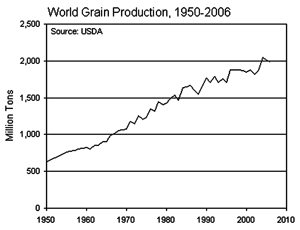WORLD GRAIN STOCKS FALL TO 57 DAYS OF CONSUMPTION
GRAIN PRICES STARTING TO RISE
15 June 2006 :: Lester R. Brown
This year’s world grain harvest is projected to fall short of consumption by 61 million tons, marking the sixth time in the last seven years that production has failed to satisfy demand. As a result of these shortfalls, world carryover stocks at the end of this crop year are projected to drop to 57 days of consumption, the shortest buffer since the 56-day-low in 1972 that triggered a doubling of grain prices.
World carryover stocks of grain, the amount in the bin when the next harvest begins, are the most basic measure of food security. Whenever stocks drop below 60 days of consumption, prices begin to rise. It thus came as no surprise when the U.S. Department of Agriculture (USDA) projected in its June 9 world crop report that this year’s wheat prices will be up by 14 percent and corn prices up by 22 percent over last year’s.
This price projection assumes normal weather during the summer growing season. If the weather this year is unusually good, then the price rises may be less than those projected, but if this year’s harvest is sharply reduced by heat or drought, they could far exceed the projected rises.
With carryover stocks of grain at the lowest level in 34 years, the world may soon be facing high grain and oil prices at the same time (See Figure). For the scores of low-income countries that import both oil and grain, this prospect is a sobering one.
The 2006 world grain harvest of 1,984 million tons, estimated by the USDA in its June crop report, is down 24 million tons from last year, or roughly one percent. It is down three percent from the historical high of 2,044 million tons produced in 2004.
World grain consumption has risen in each of the last 45 years except for three—1974, 1988, and 1995—when tight supplies and sharp price hikes lowered consumption (See Figure). Growth in world grain demand, traditionally driven by population growth and rising incomes, is also now being driven by the fast growing demand for grain-based fuel ethanol for cars.
Roughly 60 percent of the world grain harvest is consumed as food, 36 percent as feed, and 3 percent as fuel. While the use of grain for food and feed grows by roughly 1 percent per year, that used for fuel is growing by over 20 percent per year.
Although the rate of world population growth is projected to slow further, the number of people to be added is expected to remain above 70 million a year until 2020. Each year the world’s farmers must try to feed an additional 70 million people, good weather or bad. This growth is concentrated in the Indian subcontinent and sub-Saharan Africa, which is where most of the world’s hungry people live.
When incomes begin to rise, low-income consumers diversify their diets, shifting from a diet dominated by starchy foods, such as rice, corn, wheat, and cassava, to a more diverse diet, one that incorporates grain-intensive products such as meat, milk, and eggs. In high-income countries like the United States and Canada, grain consumed indirectly in the form of livestock products far exceeds that consumed directly as food.
Rising incomes worldwide are enabling some 3 or 4 billion low-income consumers to move up the food chain, consuming more poultry, pork, beef, milk, eggs, and farmed fish. World meat production, which climbed from 44 million tons in 1950 to 265 million tons in 2005, moves higher each year. During this 55-year span, production per person more than doubled, going from 17 kilograms to 41 kilograms.
The newest, potentially huge claimant on world grain supplies, the use of grain to produce fuel ethanol, is concentrated in the United States where a projected 55 million tons, or one fifth of the projected 268-million-ton corn harvest for 2006, will be used for this purpose. This year the climbing use of corn to produce automotive fuel will catch up with the U.S. export of corn, which is also estimated at 55 million tons (See Figure). For perspective, although 55 million tons is only 16 percent of the U.S. grain harvest, it exceeds the total grain harvest of Canada.
Farmers are facing a record growth in the demand for grain at a time when the backlog of technology to raise grain yields is shrinking, when underground water reserves are being depleted, and when rising temperatures threaten to shrink future harvests.
Water tables are now falling and wells are going dry in countries that contain half the world’s people, including the big three grain producers—China, India, and the United States. In China, water shortages have helped lower the wheat harvest from its peak of 123 million tons in 1997 to below 100 million tons in recent years. Water shortages are also making it more difficult for farmers in India to expand their grain harvest. In parts of the United States, such as the Texas panhandle and in western Oklahoma and Kansas, depletion of the Ogallala aquifer has forced farmers to return to lower-yield dryland farming.
The world’s farmers are also losing water to cities. In the United States, for example, hardly a day goes by without another sale of irrigation water to small towns or large cities such as Los Angeles, San Diego, Las Vegas, and Denver. Some of these water sales are by individual farmers selling water rights to a local town. Others represent sales of water rights by entire irrigation districts, as in parts of California.
The widespread overpumping of aquifers for irrigation means we are feeding ourselves with water that belongs to the next generation. While it is widely recognized that the world is facing a future of water shortages, not everyone has connected the dots to see that this likely also means a future of food shortages.
Perhaps the most dangerous threat to future food security is the rise in temperature. Among crop ecologists there is now a consensus that for each temperature rise of 1 degree Celsius above the historical average during the growing season, we can expect a 10 percent decline in grain yields. When describing weather-reduced harvests, crop analysts often refer to the crop prospect when weather returns to normal. They fail to realize that with the earth’s climate now in flux, there is no longer a norm to return to.
More and more in recent years, crop-withering heat waves have led to major crop losses. For a recent example, the early estimate of India’s wheat harvest this year of 73 million tons dropped to 68 million tons as high temperatures during the crop’s critical growth stage in January and February shrank the harvest.
The troubling constraints on grain production growth, such as spreading water shortages and rising temperatures, are making it difficult for farmers to keep up with the record growth in demand. As a result the world grain market may become a seller’s market, one where higher grain prices, like high oil prices, are an integral part of the economic landscape. [e]
Originally Published online: 15 June 2006
(http://www.earth-policy.org/Indicators/Grain/2006.htm)
Reproduced here by Permission of Earth Policy Institute
Copyright © 2006 Earth Policy Institute

| Table 3-1. Annual Growth in World Animal Protein Production, by Source, 1990-2003 |
| Source |
|
|
|
| Beef |
|
|
|
| Pork |
|
|
|
| Mutton |
|
|
|
| Poultry |
|
|
|
| Eggs |
|
|
|
| Oceanic Fish Catch |
|
|
|
| Aquacultural Output |
|
|
|
| *Figures for 2002 — Source: See endnote 13 |
|
|
BACKGROUND:
SHIFTING PROTEIN SOURCES
FROM 'OUTGROWING THE EARTH', CH. 3, "MOVING UP THE FOOD CHAIN EFFICIENTLY"
13 June 2006 :: Lester R. Brown
The composition of world meat production has changed dramatically over the last half-century or so. From 1950 until 1978, beef and pork vied for the lead. Then the world meat consumption pattern began to change as economic reforms adopted in China in 1978 led to a dramatic climb in pork production, pushing it far ahead of beef worldwide. [Full Story]
WORLD FOOD SECURITY DETERIORATING
FOOD CRUNCH IN 2005 NOW LIKELY
Lester R. Brown :: 5 May 2004
Closing the gap in the world grain harvest this year following four consecutive grain harvest shortfalls, each larger than the one before, will not be easy. The grain shortfall of 105 million tons in 2003 is easily the largest on record, amounting to 5 percent of annual world consumption of 1,930 million tons. The four harvest shortfalls have dropped world carryover stocks of grain to the lowest level in 30 years, amounting to only 59 days of consumption. Wheat and corn prices are at 7-year highs. Rice prices are at 5-year highs. [Full Story]













